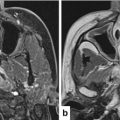Regimens
N
ORR (%)
Median survival (months)
Reference
Cisplatin/5-FU
249
32 %
5.5 months
[26]
vs.
Cisplatin
17 %
5 months
vs.
5-FU
13 %
6.1 months
Cisplatin/methotrexate/bleomycin/vincristine
382
34 %
8.2 months
[25]
vs.
Cisplatin/5-FU
31 %
6.2 months
vs.
Cisplatin
15 %
5.3 months
Cisplatin/5-FU
277
32 %
6.6 months
[11]
vs.
Carboplatin/5-FU
21 %
5 months
vs.
Methotrexate
10 %
5.6 months
Cisplatin/pemetrexed
795
12.1 %
7.3 months
[27]
vs.
Cisplatin
8 %
6.3 months
The cisplatin plus paclitaxel combination was also compared with cisplatin plus 5-FU in a randomized phase III trial, but this trial showed no significant difference in OS or response rate (ORR: 22 and 29 %; median OS: 9 and 8 months, respectively) [10].
Epidermal Growth Factor Receptor (EGFR) Inhibition
The epidermal growth factor receptor (EGFR) is a member of the HER tyrosine kinase growth factor receptor family. Its expression is frequently dysregulated in SCCHN and leads to a poorer prognosis [28].
The most studied EGFR inhibitor in SCCHN is cetuximab [29]. Cetuximab is a chimeric IgG1 monoclonal antibody that specifically binds to the EGFR with high affinity. Cetuximab has been studied in phase III trials in combination with chemotherapy and significantly improves survival when added to the combination of cisplatin and 5-FU or carboplatin and 5-FU [4]. In this study, the ORR was 20 % in the chemotherapy arm alone and 36 % in the chemotherapy plus cetuximab group with a median survival of 7.4 and 10.1 months, respectively (Table 14.2).
Table 14.2
Selected phase III trials investigating EGFR or pan-HER inhibitors
Regimens | N | Median PFS (months) | Median survival (months) | Reference |
|---|---|---|---|---|
aPlatin/5-FU | 442 | 3.3 months | 7.4 months | [4] |
versus | ||||
Platin/5-FU/cetuximab | 5.6 months | 10.1 months | ||
aCisplatin/5-FU | 667 | 4.6 months | 9 months | [31] |
versus | ||||
Cisplatin/5-FU/panitumumab | 5.8 months | 11.1 months | ||
bMethotrexate | 483 | 1.7 months | 6 months | [18] |
versus | ||||
Afatinib | 2.6 months | 6.8 months |
Interestingly, cetuximab has been investigated in combination with paclitaxel (80 mg/m2) in the first-line treatment of recurrent and/or metastatic SCCHN [30]. Overall response rate was 54 % with 22 % complete responses and a disease control rate of 80 %. Median progression-free and overall survival times were 4.2 and 8.1 months, respectively. Cetuximab was also investigated in three phase II trials in patients who progressed on cisplatin or carboplatin-based chemotherapy [29]. The median time to disease progression ranged between 2.2 and 2.8 months, and the median overall survival ranged between 5.2 and 6.1 months. No patients who progressed on cetuximab alone responded to additional platinum. These survival data compared favorably with those from a retrospective study that investigated best supportive care or chemotherapy in this setting (median survival, 3.4–3.6 months).
Panitumumab and Zalutumumab are two other monoclonal antibodies that target the EGFR [5, 31]. A phase III trial compared cisplatin plus 5-FU with or without panitumumab [31] (Table 14.2). Panitumumab did not significantly improve the OS (median: 11.1 months versus 9.0 months, p = 0.14), the primary endpoint, but did yield significantly higher ORR (36 % versus 25 %; p = 0.007) and PFS (5.8 months vs. 4.6 months; p = 0.004). An unplanned analysis of the results stratified by tumor p16 status suggested that panitumumab improved OS and PFS in patients with p16-negative tumors but not in those with p16-positive. Zalutumumab did not improve overall survival versus BSC or methotrexate (6.7 versus 5.2 months, p = 0.06) in palliative SCCHN that progressed after platinum therapy but significantly prolonged PFS (p = 0.001) [5].
EGFR tyrosine kinase inhibitors are orally available small molecules. The two main compounds are erlotinib and gefitinib. Gefitinib has been investigated in two phase III trials in palliative patients but did not show any survival benefit. The first trial compared gefitinib to methotrexate and the second investigated docetaxel plus gefitinib versus docetaxel plus placebo [20, 32].
Human Epidermal Receptors (HER) Inhibition
A minority of patients will benefit from anti-HER or anti-EGFR therapy. Blocking the other receptors of the HER family is one approach to try to overcome anti-EGFR therapy resistance.
A second generation of HER inhibitors, the irreversible small molecule pan-HER inhibitors including afatinib and dacomitinib, has been developed [18, 33]. By covalently binding and irreversibly blocking all kinase receptors from the ErbB family, a prolonged inhibition is obtained with the aim of improving clinical activity. The phase III trial LUX-Head and Neck 1 randomized 483 patients with recurrent and/or metastatic SCCHN progressing after first-line platinum regimens to oral afatinib (40 mg/day) or intravenous methotrexate (40 mg/m2/week) [18]. Afatinib significantly improved PFS versus methotrexate (median 2.6 vs. 1.7 months; p = 0.030), without significant improvement in OS (Table 14.2).
The IgG1 antibody MEHD7945A blocks EGFR- and HER3-mediated signaling and mediates ADCC [34]. A phase I study of 36 patients showed promising safety profile and evidence of antitumor activity [35]. Best response included two partial responses in SCCHN and six stable diseases lasting more than 8 weeks (two non small-cell lung cancer and four colorectal cancer). Seven out of eight patients were previously treated with EGFR inhibitors. A randomized phase II trial compared MEHD7945A to cetuximab in patients with recurrent/metastatic SCCHN that progressed during or shortly after platinum-based chemotherapy. No difference between the two arms could be detected in this trial [36].
Predictive Biomarkers for Therapies Targeting the HER Family
In SCCHN, we are lacking predictive biomarkers to predict treatment activity or resistance. Hypotheses to explain anti-EGFR resistance include the acquisition of oncogene activating mutations, activation of alternative signaling growth pathways, or modifications in tumor composition.
The majority of the trials support the hypothesis that anti-EGFR or anti-HER therapies are more active in p16-negative and HPV-negative SCCHN [18, 31, 36] (Table 14.3). Only the EXTREME trial suggested that the survival benefit of chemotherapy plus cetuximab over chemotherapy could be independent of tumor p16 and HPV status [37]. However, all these analyses are impaired by the low number of patients in the subgroups investigated, the different cutoff used among the studies to assess p16 positivity, and the fact that the significance of p16 positivity is probably different in oropharynx cancer compared with the other SCCHN subsites.
Table 14.3
p16 as a predictive biomarker of EGFR or HER inhibitors
Regimens | N | Population | Benefit | Reference |
|---|---|---|---|---|
Platin/5-FU | p16+ = 18 p16− = 178 | Recurrent/metastatic: first line | p16−: HR: 0.82 (OS) | [37] |
versus | ||||
Platin/5-FU/cetuximab | p16+ = 23
Stay updated, free articles. Join our Telegram channel
Full access? Get Clinical Tree
 Get Clinical Tree app for offline access
Get Clinical Tree app for offline access

|


